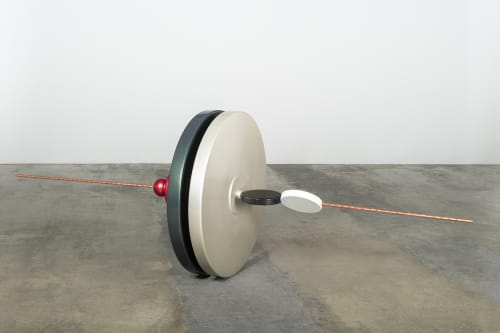“Multipolarity” at Fridman Gallery is a leap into the metaphysics of ar- tifice. Strewn around the room are objects––square, cylindrical, polygo- nal––all skewered by what appear to be copper rods. Some “skewers” stand propped against walls. Others lie prone on the ground, abstracted flatlandesque bodies begging to be decoded and deconstructed. It is ob- vious to all that they conceal or contain another dimension, but what?
Reuven Israel first began using the copper rod as a building agent on which to place his works in progress until he had determined how to assemble them. It was only a matter of time before he dis- covered that the rods were in fact the missing sculptural element he sought. Israel constructs the pierced units, often orbs or discs, out of MDF, a prefabricated material he has been fascinated with for over 10 years. To Israel, MDF can stand in for almost any shape or texture other than its original. It is the mother of artifice, and artifice––to him––is the cornerstone of art. Nothing representative can ever itself be the subject it represents. The representation is inherently distinct. Israel shapes the MDF by hand into various shapes, then stacks, paints and polishes them until no trace of his touch, nor the original MDF material, can be detected. The result is a series of sculptures that “look perfect but don’t feel perfect.” Polished orbs appear full, heavy, machine-made when they are ac- tually hollow, light and painstakingly crafted. Geometrical shapes resemble plastic nuclear waste symbols or pop art flowers, while others still remind one of piano keys, a xylophone or instrument of similar nature. They are all of these, yet none all at once.
Israel’s sculptures are reminiscent of symbols, graphics or icons, fa- miliar elements of our two-dimensional world, relics or reconstructed artifacts of the digital and print cultures we navigate daily, populated by abstracted signs. Even the works’ titles ... SMBTD, SBMBOOL ... remind us of the encoded universe we inhabit, each one an acronym, a
layer of language stacked on top of other programmed layers of trans- lation. Israel shares his inspirations, one being the Speculative Real- ism School of philosophy. Israel describes his work as an attempt “to break through to outer space,” “to be fantastic ... to be fantastical” or to make the fantastic out of the ordinary. In effect, the works resemble a type of alchemy, a Hollywoodesque sleight of hand, manipulating ordinary materials multiple times until they transcend their original identity, leaving no trace, hint or clue for the viewer.
But I only truly understand Israel’s world when I see his drawings. Drifting orbs and shapes float on a field of black ink. In minuscule form, the characters of Israel’s universe remind me of my Pacman and Atari youth. These objects are similar in shape but smaller in scale compared to the “tokens” or “talismans” that he has stacked into monumental totems. I finally grasp what he calls the “intentional ran- domness” of his world. Returning to “Multipolarity,” I see the skewers in a new light. They are of human scale. Those propped against the walls stand about human height. Those lying on the ground seem to be prostrated or at rest. They are companions to us men and women, skewering, hooking, and attaching us to their chain of objects.
In the end, I decide that I prefer those leaning against the gallery’s wall. They feel less easily commodified than their supine friends, whom I find too self-contained, self-sustaining, too safe, ready-made, a succinct statement or eager possession for the consumer.

